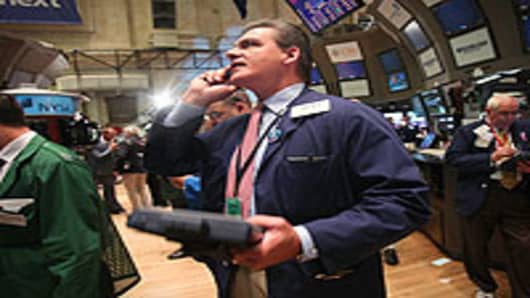Stocks may have seen their highs for year, but it's less clear whether they've hit their lows.
Several technicians say the May 2 intraday high of 1370 looks to be the top of the year's trading range for the S&P 500, based on the chart action, though many fundamental strategists continue to have targets of 1400 or better for year end.
"After bouncing up and down Monday thought Thursday, I think Friday's action was very encouraging. We had a second straight up day. We hit some near-term resistance, but I don't think this rally is going to lead to new highs, and I don't think it's a rally that should be bought," said Paul LaRosa of Maxim Group.
During last week's frenetic ride, the S&P set an intraday low of 1101, which technicians see as a new near-term bottom.
"I think that's the near term low. I think what will happen is we'll rally up to the 1250 area, and then we're going to turn around again. You want to see us find a bottom hopefully comfortably above that (1100)....It's going to take several more months of trading activity to try to determine if this is a good intermediate bottom," LaRosa said.
Oppenheimer Asset Management chief market technician Carter Worth, on the other hand, believes the low point of last week was also the low point for the year.
"The plunge of the past two weeks also represents such aggressive price discovery (based on the 'retests' in so many individual stock charts and the epic volume associated therewith) that last week's low on Wednesday at 1101.54 is very likely the low for the year," he wrote.
Worth also believes the May 2 high will be the high for the year. He said the S&P had traded in an unusually tight range of 1250 to roughly 1350 since the start of the year, so that anybody who bought stock in the past six months is "trapped" and investors who bought stock higher will look to recover their losses if stocks move higher.
He said this type of "overhead supply" will trigger selling on market strength, as the shareholders who bought in at higher levels try to recover their money. That will keep a lid on the market, and makes it likely that the May high will stand. He previously expected a high of 1400 or better.
Andrew Burkly of Brown Brothers Harriman said he too believes that 1370 was the high for the year and his year end target remains 1250. "Overall, we're not buying into the rally here," he said, adding if the S&P moved toward 1250 it could be a selling opportunity. "Maybe then we retest the lows and undercut them a little."
"This rally may play out over the next couple of weeks and then in September you could start to see more volatility on the downside," he said.
Scott Redler of T3Live.com said 1100 will definitely become a support level, but he also says the market may test below that level. He too expects selling to kick in if the market gets towards 1250, a key resistance area.
"I think the high of the year is in, but there's only a 50 percent chance the lows are in," he said. "I think the crucial level will be 1225 to 1250 area. I'm not thinking a "V" shaped move off of that to 1100. I'm thinking a "W."
He added: "I think it's going to be churny, choppy to the upside, but once we get close to 1225, some of the bigger players will come out to probably short the move and test the mettle of the market. It's now in the easy snap back phase."
The 1250 area was also the level where the neckline broke in a recent head and shoulder pattern, which predicted a negative outcome when technicians started watching it a couple of weeks ago.
"I think some of those bigger levels will come into play later this week," he said.
LaRosa said he was a buyer into last week's selling because the market had hit his targets but he's now cautious.
"When we had the flash crash it took four full months for the bottom to form. That led to a good rally that started Labor day and lasted through April. I think we're probably three to four weeks into this, and it's going to take two to three months at a minimum. This is where you're going to have to see the chart data and determine if we have made a base," he said.
LaRosa said currently about 80 percent of the stocks on the NYSE look technically weak. "There's too many stocks rallying into resistance. There's too many stocks with bad charts," he said.
Questions? Comments? Email us at marketinsider@cnbc.com




